Design solution: guided tool syncs with an in-store traffic light system
Timeline
January - May 2021
January - May 2021
Team
Sara Choi, deliverables anchor
Daisy Dai, liaison anchor
Anthony DeArmas, research anchor
Zenas Lim, project lead
Sara Choi, deliverables anchor
Daisy Dai, liaison anchor
Anthony DeArmas, research anchor
Zenas Lim, project lead
Role
UX designer
HCI researcher
UX designer
HCI researcher
Platform
Figma
Miro
Adobe Premiere Pro
Blender 3D
Full report
Figma
Miro
Adobe Premiere Pro
Blender 3D
Full report
Overview
Context
Our project addresses crowd-induced stress in supermarkets, intensified by COVID-19, by focusing on the shopping habits of college students navigating their transition to independent shopping. We developed a design intervention that alleviates this stress and offers a lasting, improved grocery shopping experience.
Background research
Literature review
To get a sense of the existing research landscape, we conducted a literature review examining the role that physical environments and social interactions play in influencing social behavior. We came away with five key themes informing our research objectives.
Crowding as a stressor
Crowding is a significant source of stress rooted in our evolutionary past of resource competition. It occurs when a person’s demand for space exceeds supply, leading to psychological stress. This is particularly evident in everyday situations like grocery shopping, which is considered a highly stressful task due to crowding and queueing (Aylott & Mitchell, 1998).
Real-time crowding information reduces stress
Studies show that providing real-time crowding information (CI) can significantly reduce stress. People who are aware of crowd levels are more likely to avoid congested areas, leading to lower stress and better crowd distribution (Adam et al., 2020).
Social anxiety and familiar environments
Individuals with high social anxiety experience less stress in familiar environments. Research found that college students with higher social anxiety levels preferred familiar spaces to reduce feelings of vulnerability (Gong et al., 2019).
Impact of social learning on shopping behavior
Social influences, such as herd mentality, shape consumer behavior, particularly in stressful shopping environments. During the COVID-19 pandemic, social learning led to increased panic-buying and larger grocery trips, driven by the actions of others (Eriksson & Stenius, 2020).
COVID-19 and behavioral shifts
Fear of COVID-19 significantly altered shopping behaviors. Those most fearful of the virus showed increases in panic buying, poor eating habits, and avoidance of grocery shopping, reflecting how public health concerns can drive irrational consumer behaviors (Kowalczuk & Gębski, 2021).
Research objectives
We wanted to explore the implications of information availability in human behavior, as existing research has shown that providing real-time crowding information increases crowd avoidance behavior. We were interested in expanding these findings to grocery shopping because people associate grocery stores with tasks and limited resources necessary for survival. Based on background research findings, we investigated the effects of manipulating information availability and proposed the following hypotheses:
H1: Consumers provided with crowding information will be less likely to enter congested areas than consumers who were provided with no information.
H2: Encouraging consumers to visit less crowded areas will facilitate effective redistribution of crowd levels, thereby reducing stress levels.
Not all shoppers display irrational behavior, however, which suggests that the same stress manifests in different people in different ways. Identifying factors contributing to these differences would inform our design decisions to develop an intervention that amplifies positive aspects of grocery shopping instead of merely eliminating the negative aspects.
H1: Consumers provided with crowding information will be less likely to enter congested areas than consumers who were provided with no information.
H2: Encouraging consumers to visit less crowded areas will facilitate effective redistribution of crowd levels, thereby reducing stress levels.
Not all shoppers display irrational behavior, however, which suggests that the same stress manifests in different people in different ways. Identifying factors contributing to these differences would inform our design decisions to develop an intervention that amplifies positive aspects of grocery shopping instead of merely eliminating the negative aspects.
Design process
Design process
Phase 1: Discovery
During the Discovery phase, our goal was to use design ethnography to understand current grocery shopping habits and behavioral patterns of our user group.
Online surveys
Our Google Forms survey, conducted over 1.5 weeks, provided valuable data on grocery shopping patterns including frequency, store preferences, and crowd avoidance concerns before and after COVID-19. It also gathered insights into shoppers' top concerns in crowds and their preferred shopping days and times.
Contextual interviews and field observation
We followed five participants on their weekly grocery trips using a mix of contextual interviews and field observations to explore their behaviors, preferences, and stressors throughout the shopping process. Interviews were conducted at the store entrance, midway through shopping, and at checkout to understand their choices and feelings about crowd density at each stage.
Findings
Resistance to changing shopping habits
Most shoppers are reluctant to change their routines, including shopping times, despite the availability of online crowd information. Many find it inconvenient or unreliable and often shop based on their social schedules (e.g., coordinating with friends for transport).
Preference for familiarity
Shoppers prefer familiar stores and routines, often shopping weekly at the same locations. They enjoy the sense of control and comfort that comes from knowing store layouts and shopping leisurely, with some even viewing grocery shopping as a form of "discovery" rather than a chore.
Challenges with grocery lists
Shoppers frequently use grocery lists, but these can hinder their ability to navigate crowded spaces. Lists are often disorganized, and referencing them requires multitasking, which can create additional stress, such as battery drain or fumbling with paper.
Fear of inconveniencing others
Shoppers are conscious of not inconveniencing other customers, a fear that predates the pandemic but has intensified due to heightened stress levels. Concerns about holding up lines or forgetting items lead to discomfort in social situations, even influencing their choice of checkout lanes.
Coping strategies for crowds
Shoppers experience discomfort in crowded environments, with many using both passive and active coping strategies to avoid crowds. Some wait for crowds to clear, while others actively change aisles or abandon their carts to reduce stress from social interaction and crowding.
Phase 2: Definition
In the Definition phase, we analyzed our data to build a clear situational picture of user behavior, motivations, and beliefs to specify user requirements.
Data analysis
We received 48 survey responses and used Google's auto-generated summary graphs to observe high-level trends. We then investigated correlational relationships such as whether participants shopping at large and mid-sized grocery stores were more averse to crowds and how this impacted their shopping frequency.
Affinity map
User journey map
Phase 3: Development
In the Development phase, we used insights to drive our ideation process as well as explore and refine design opportunities.
Bodystorming
We conducted bodystorming at Ithaca’s Wegmans to observe crowd interactions and explore shopping behaviors. After a 15-minute immersion to warm up, we role-played scenarios in pairs to identify opportunity areas and challenges, using the “Yes, and…” method to build upon ideas.

Bodystorming session sticky notes
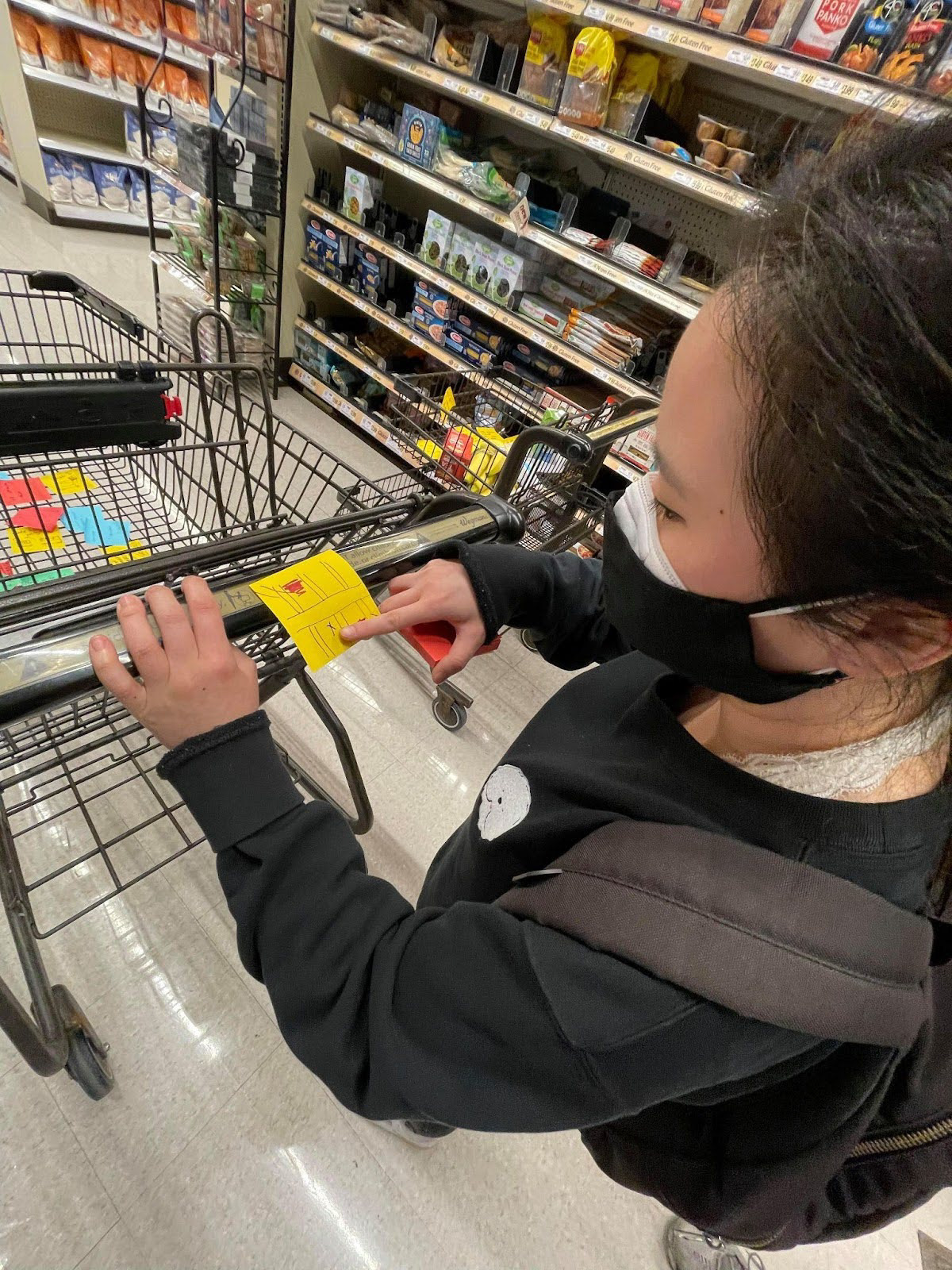
Example 1: Cart provides real-time crowding information
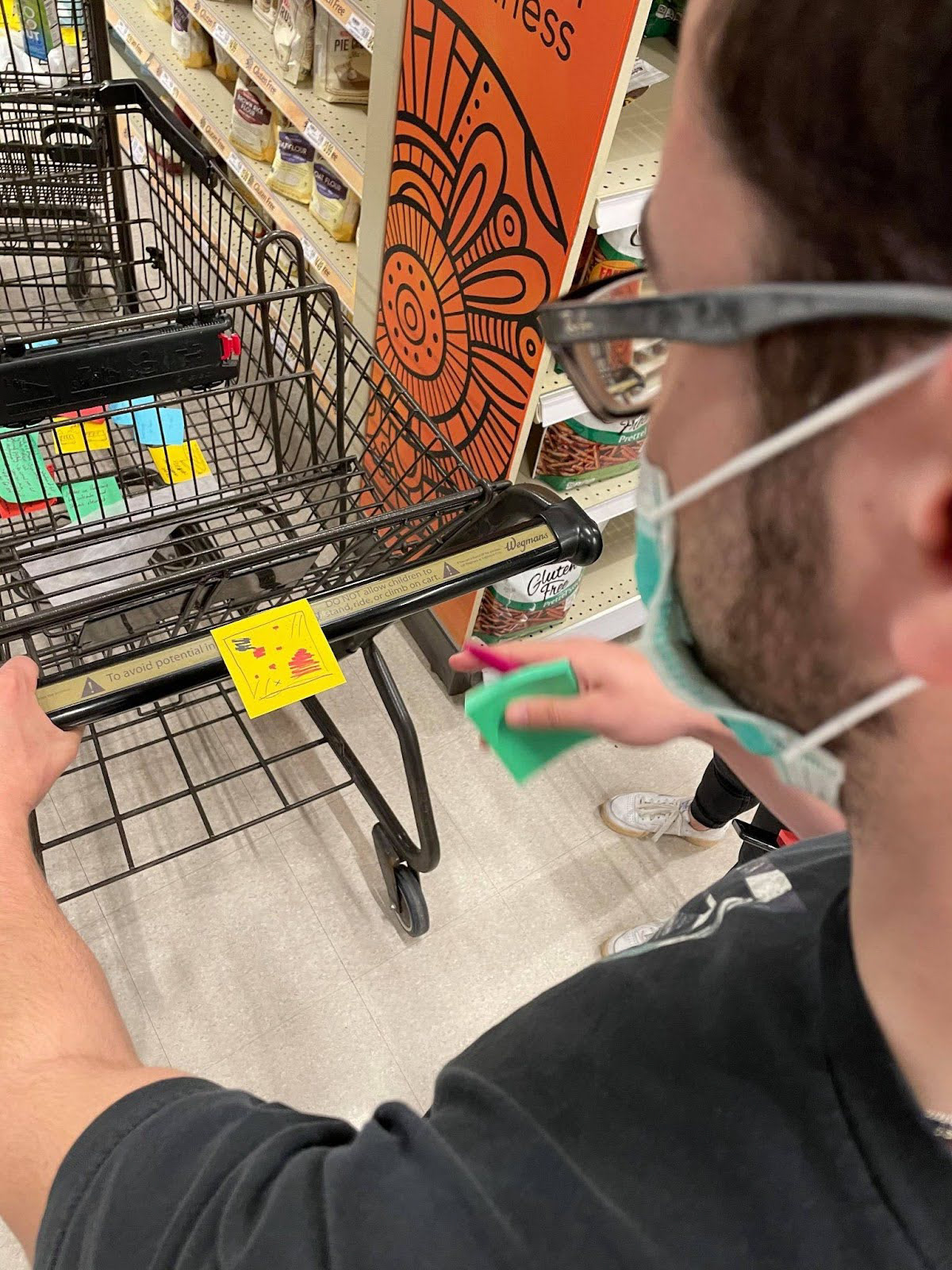
Example 1: Cart provides real-time crowding information
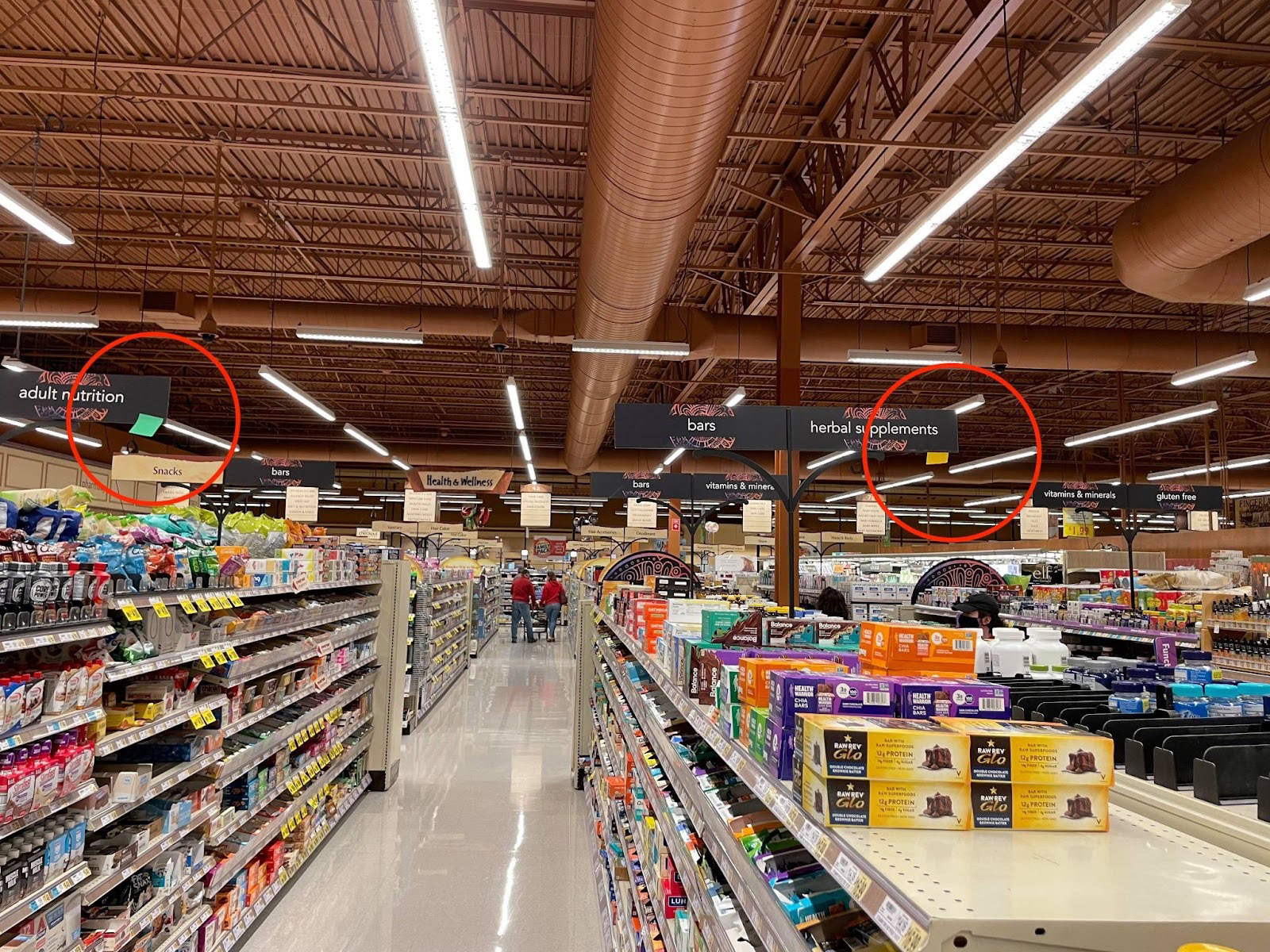
Example 2: Colored sticky notes on aisle signs indicate the current crowd level
User enactments (UEs)
Since our project involves shaping novel behaviors, role-playing or reenacting tasks in a controlled environment by simulating real-world scenarios helped us see how participants would interact with our design. This method helped us later identify pain points, preferences, and behavior patterns by testing the practicality, intuitiveness, and functionality of two directions for a design intervention: one that stays with the user, and one that manipulates the environment.
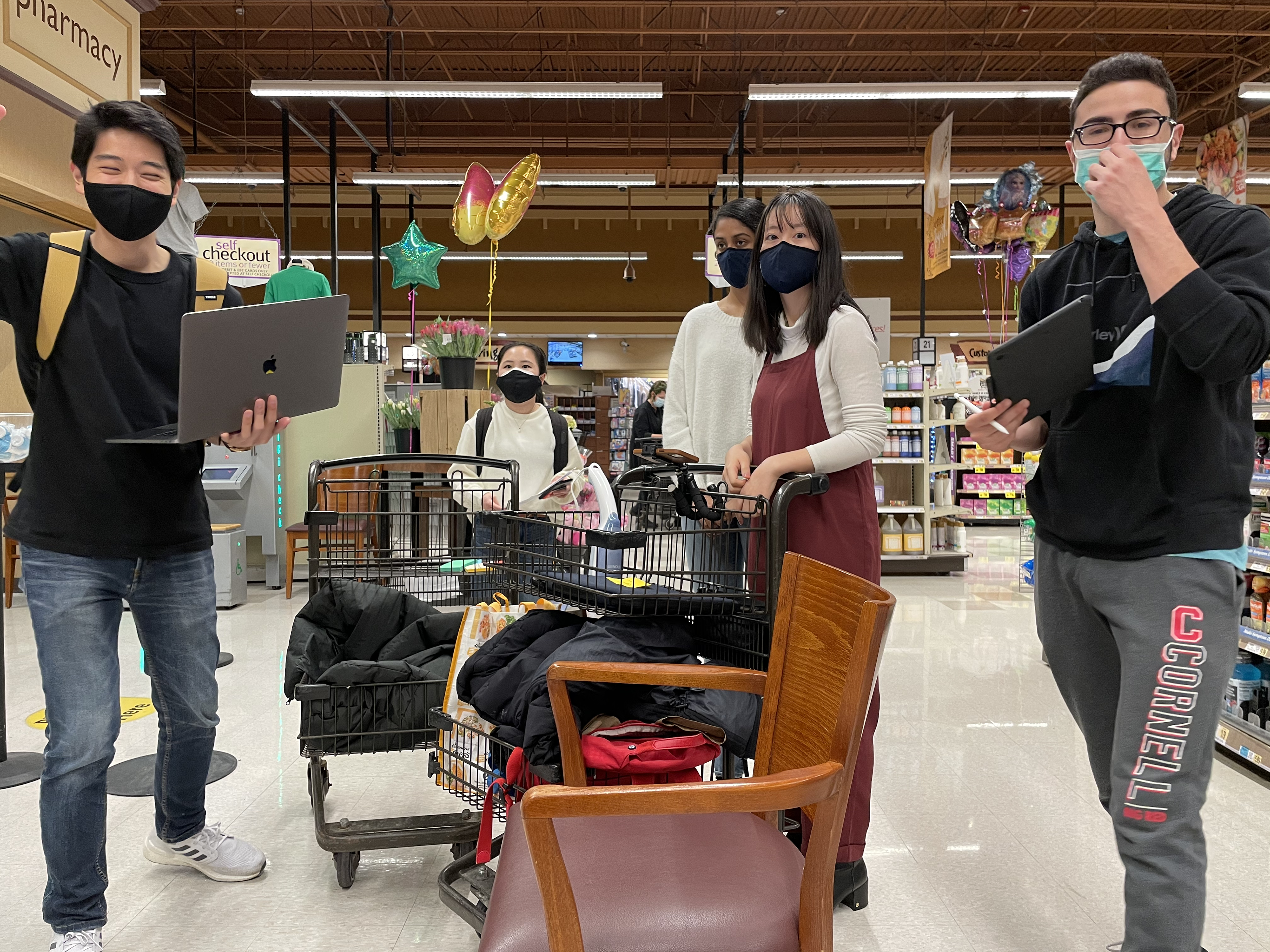
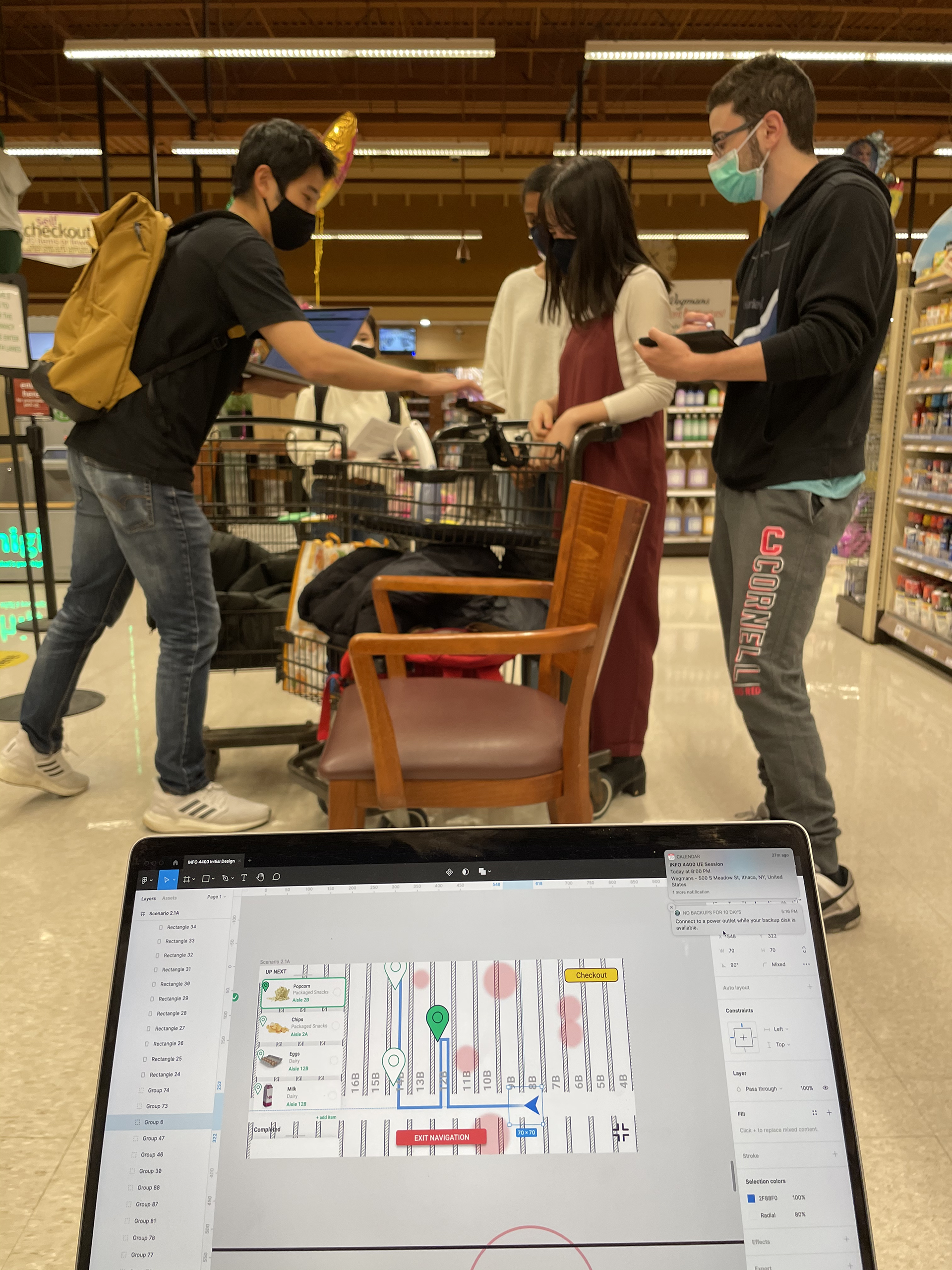
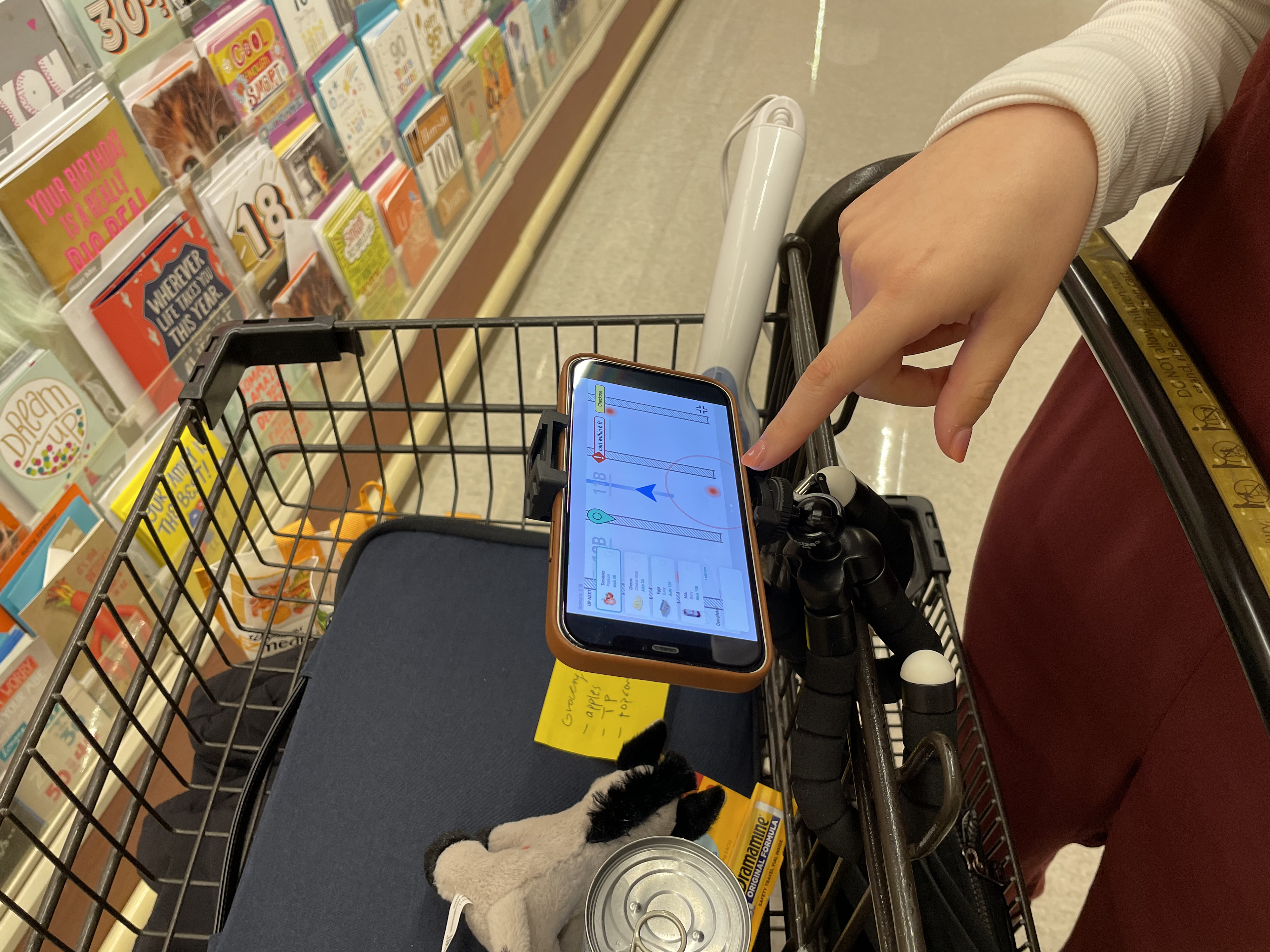
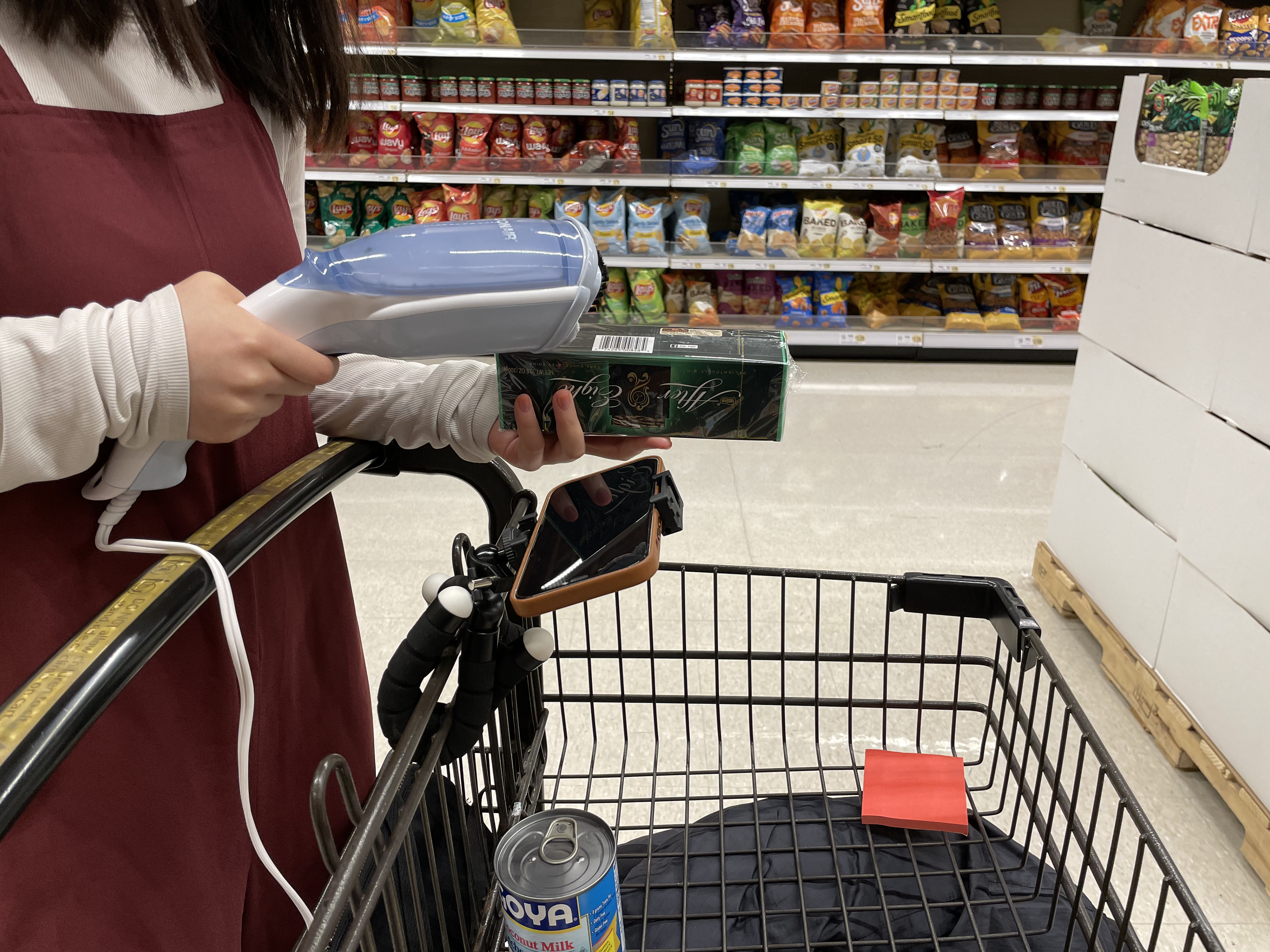
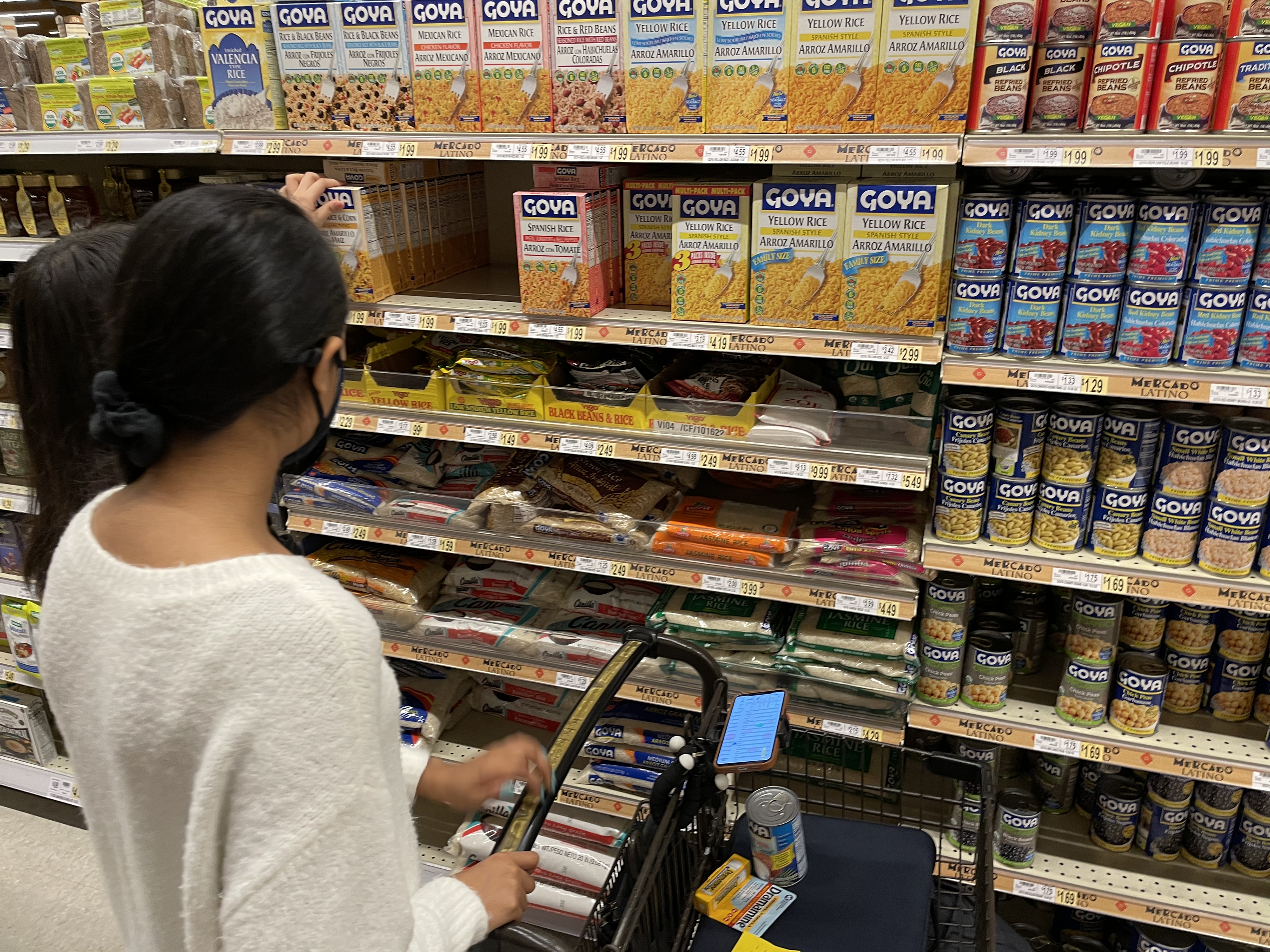
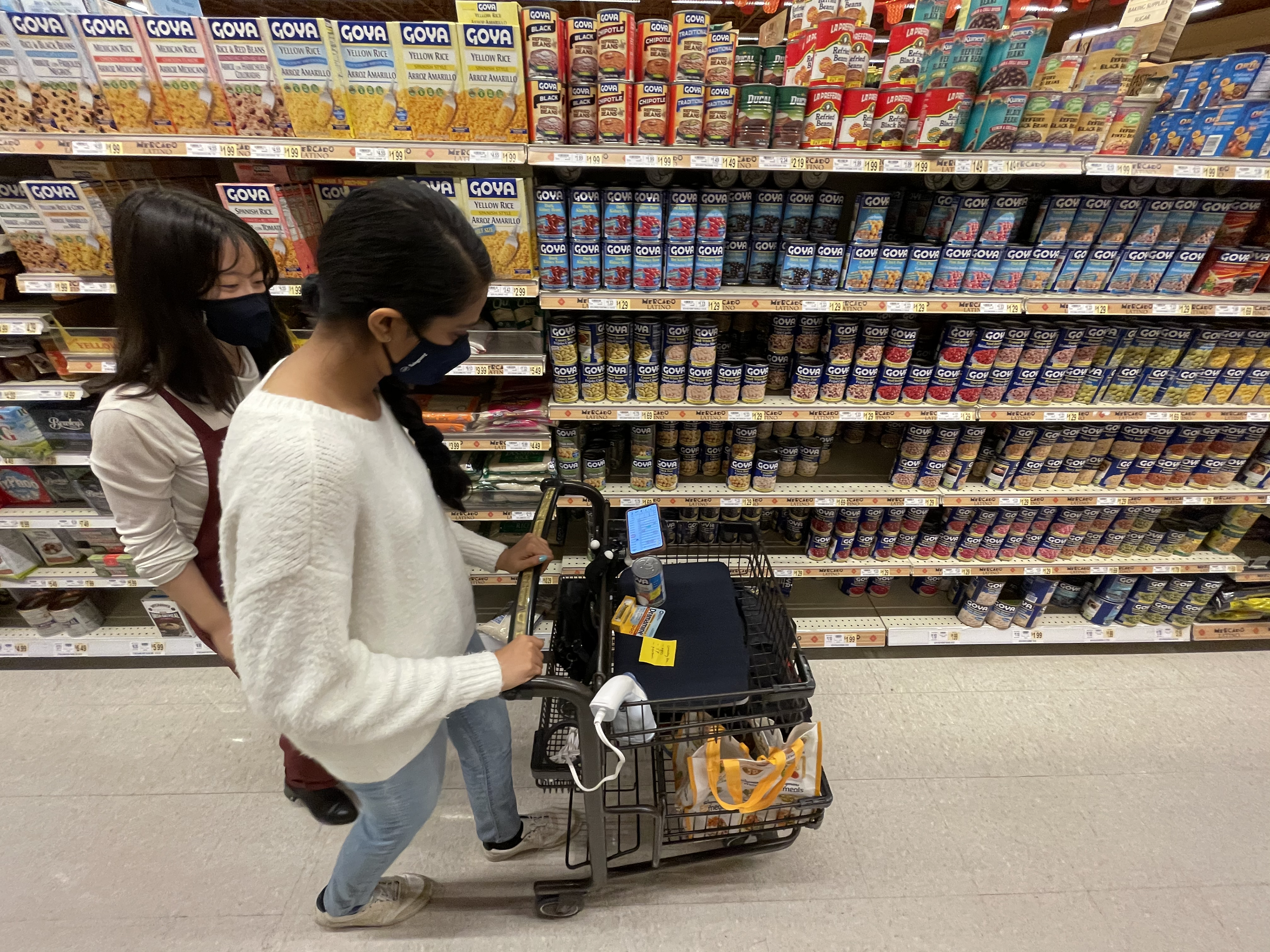
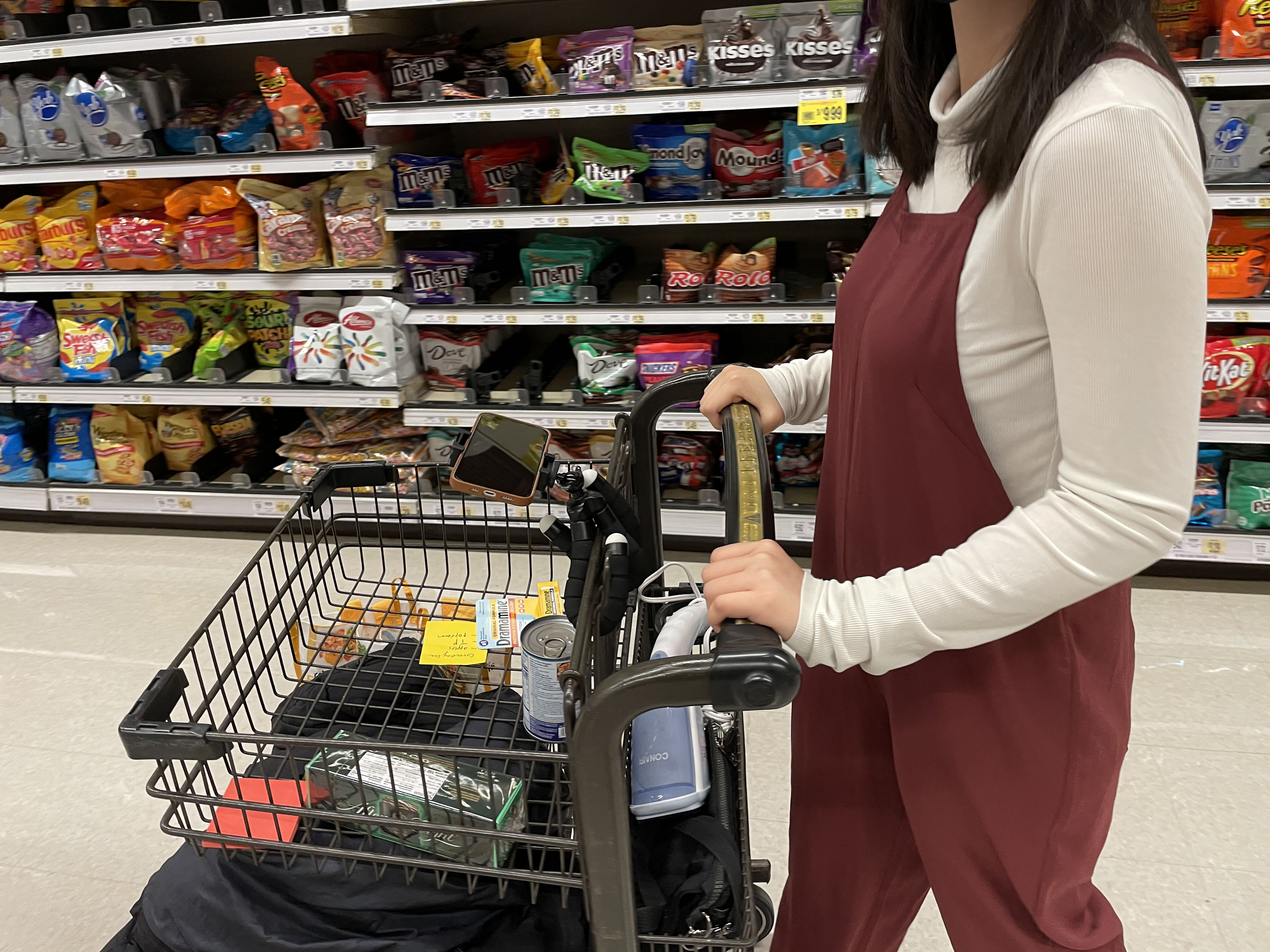
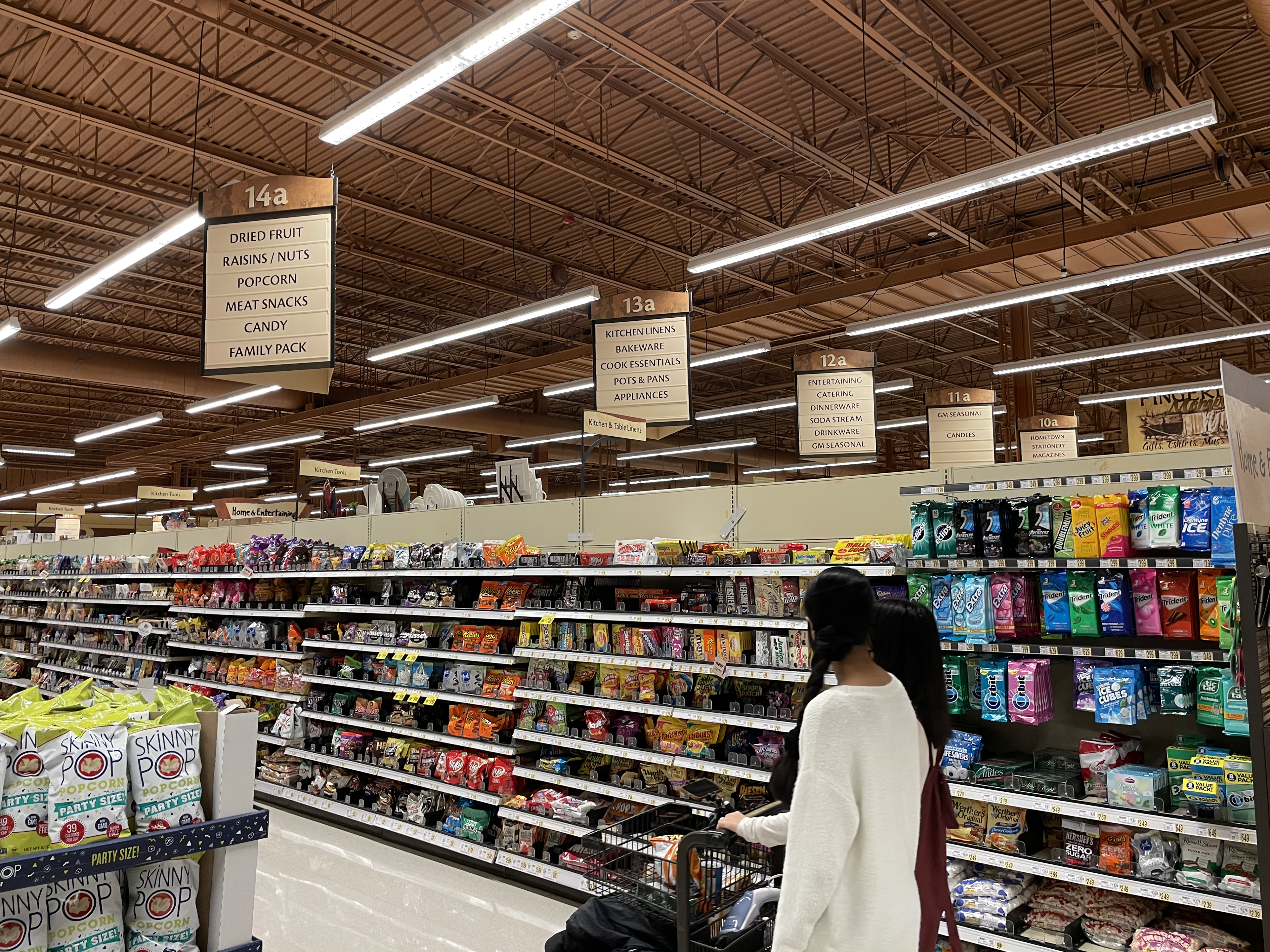
Findings
Preference for environmental cues
Participants preferred using environmental cues over digital maps, feeling it was unnatural to constantly switch between directions and navigation, so we removed the digital map based on their feedback.
Value of aisle-specific crowding information
Participants cared more about knowing if specific aisles were crowded rather than general crowd density, appreciating crowd information only when it directly impacted their shopping experience.
Utility of traffic light system
Participants appreciated the traffic light system for easy access to crowd information but found the same data on the digital map unnecessary.
Preference for personal devices
Participants preferred using their own devices over built-in shopping cart screens, valuing a sense of control.
Need for easy access
Participants were strongly against downloading an app, emphasizing the importance of a plug-and-play web-based service for easy access.
Final design
Based on observations of shoppers multitasking in-store, we explored two intervention approaches: one that stayed with the user and one that manipulated the environment. While participants preferred using their own devices over a cart-installed screen, they responded positively to crowding information from environmental indicator lights, leading us to combine both strategies in the final solution.
Based on observations of shoppers multitasking in-store, we explored two intervention approaches: one that stayed with the user and one that manipulated the environment. While participants preferred using their own devices over a cart-installed screen, they responded positively to crowding information from environmental indicator lights, leading us to combine both strategies in the final solution.
Design solution: app walkthrough + in-store light system
Part 1: Digital guide
The guiding tool is a mobile app that creates an efficient shopping route based on a list of items, displaying aisle numbers for easy navigation. Shoppers preferred this simplified approach over our initial version, which offered more detailed navigation and features like crowd alerts and proximity warnings.
Guided tool: shopping user flow
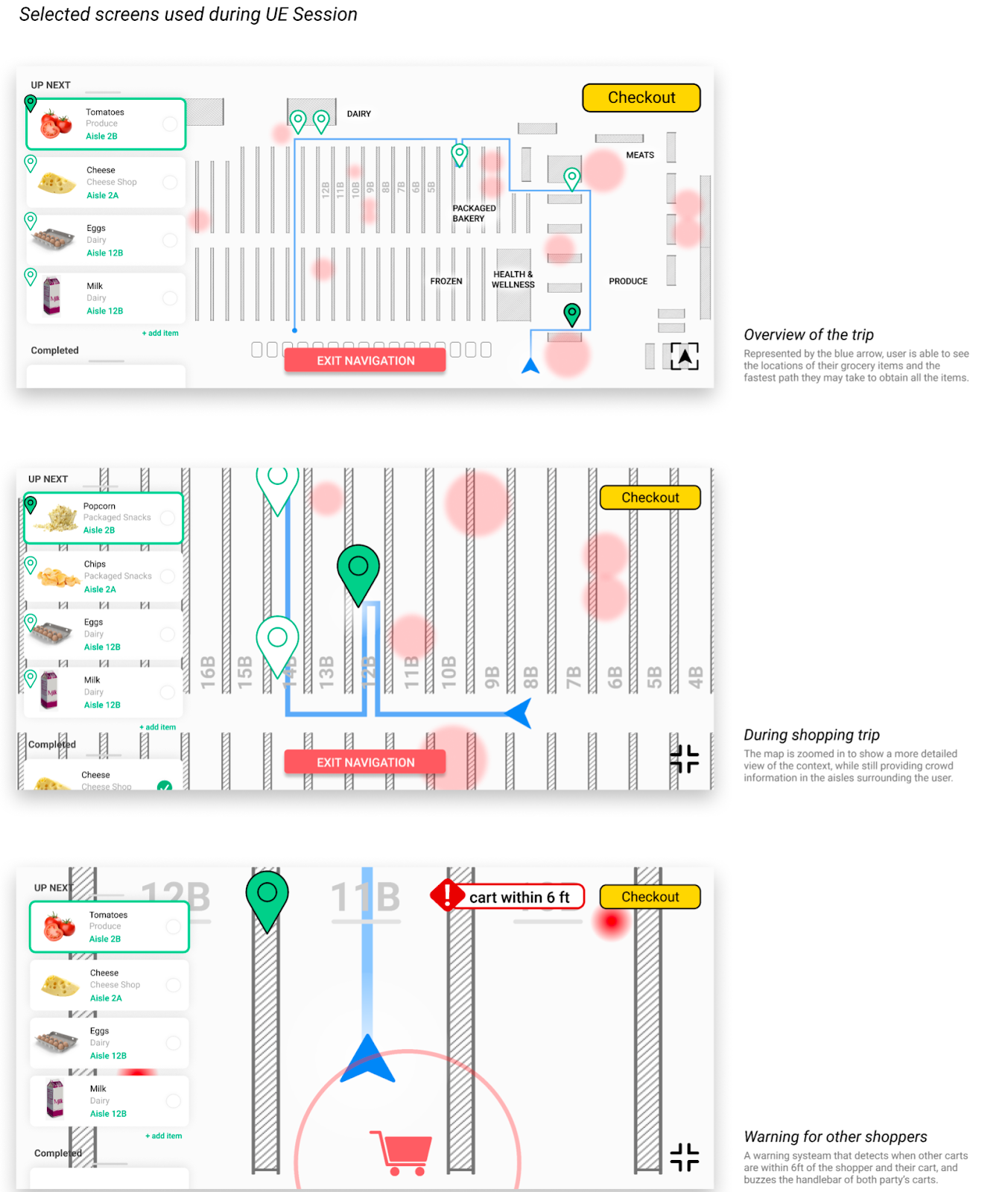
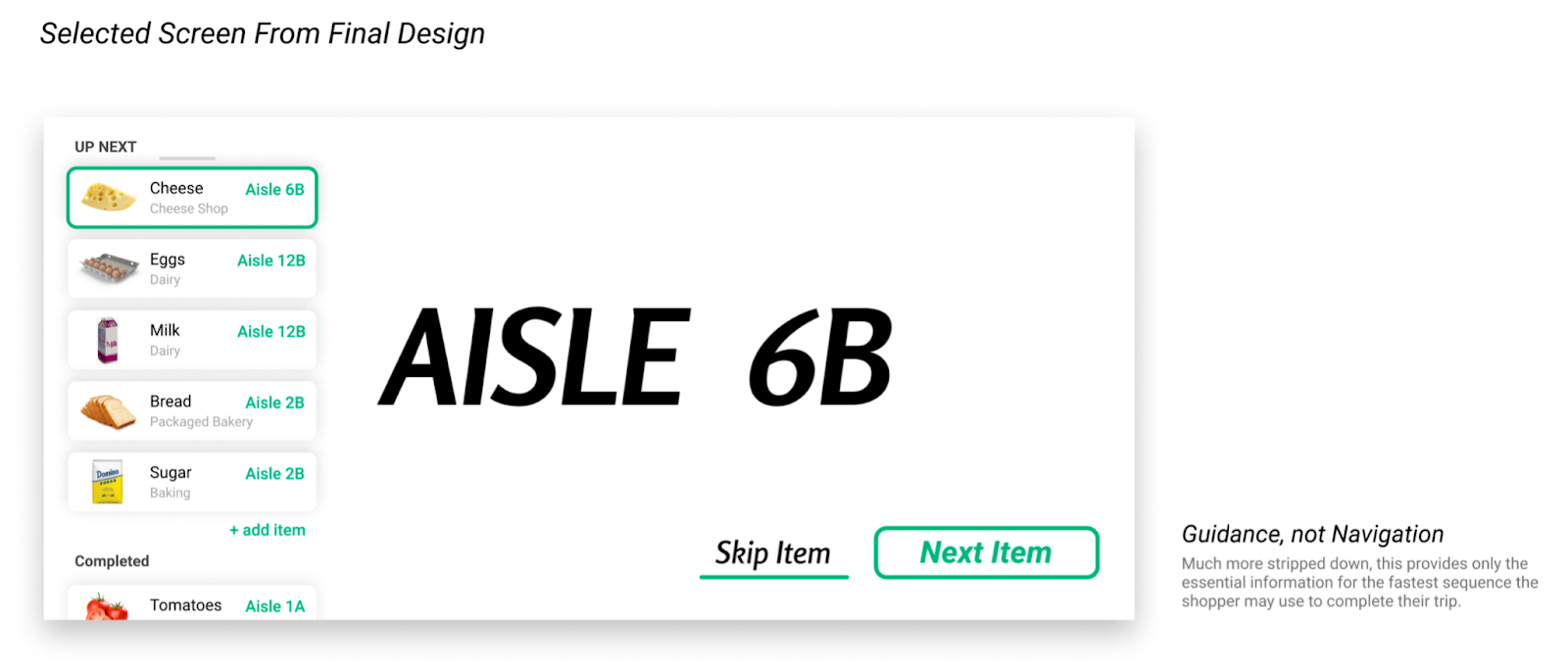
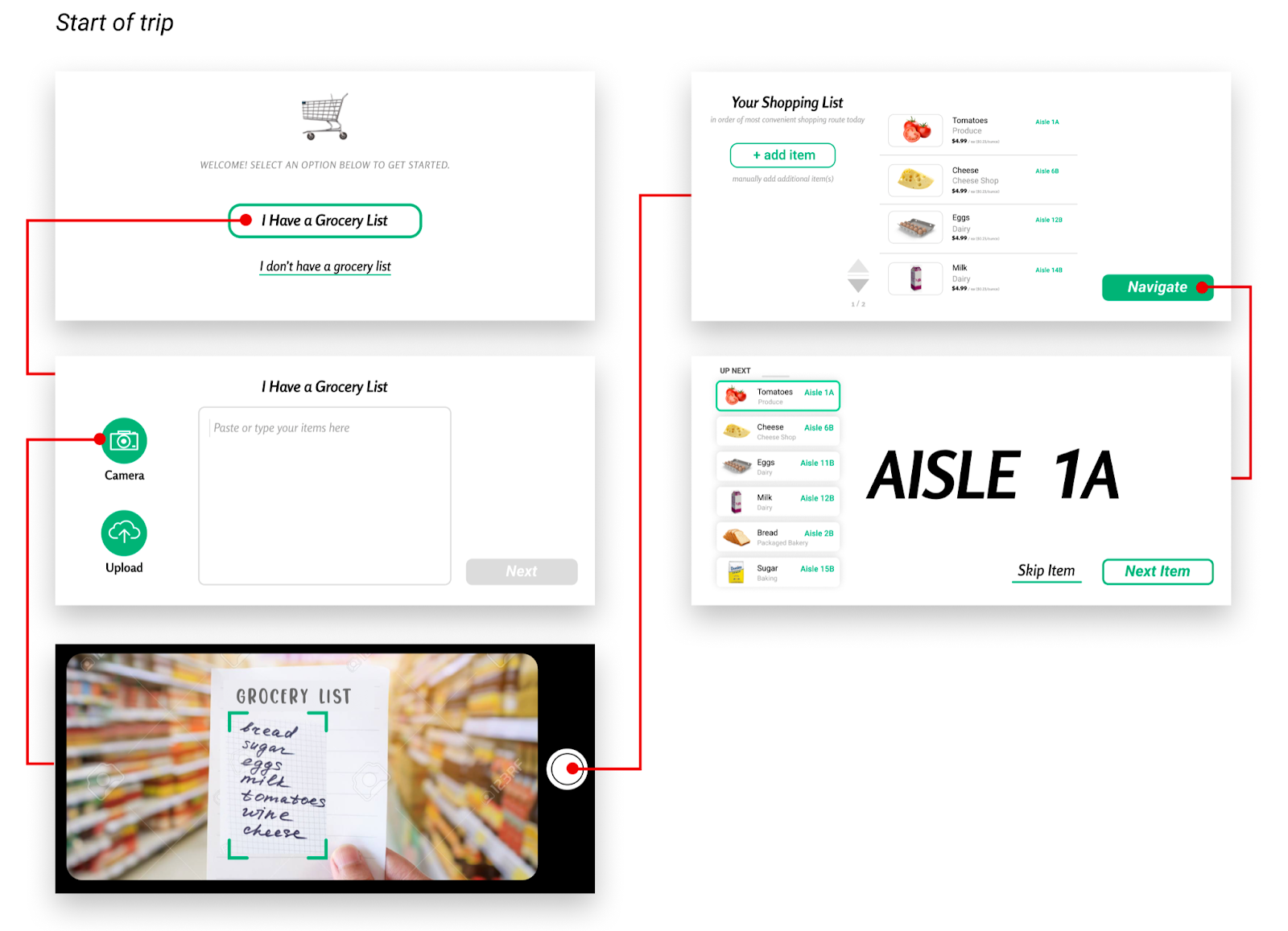
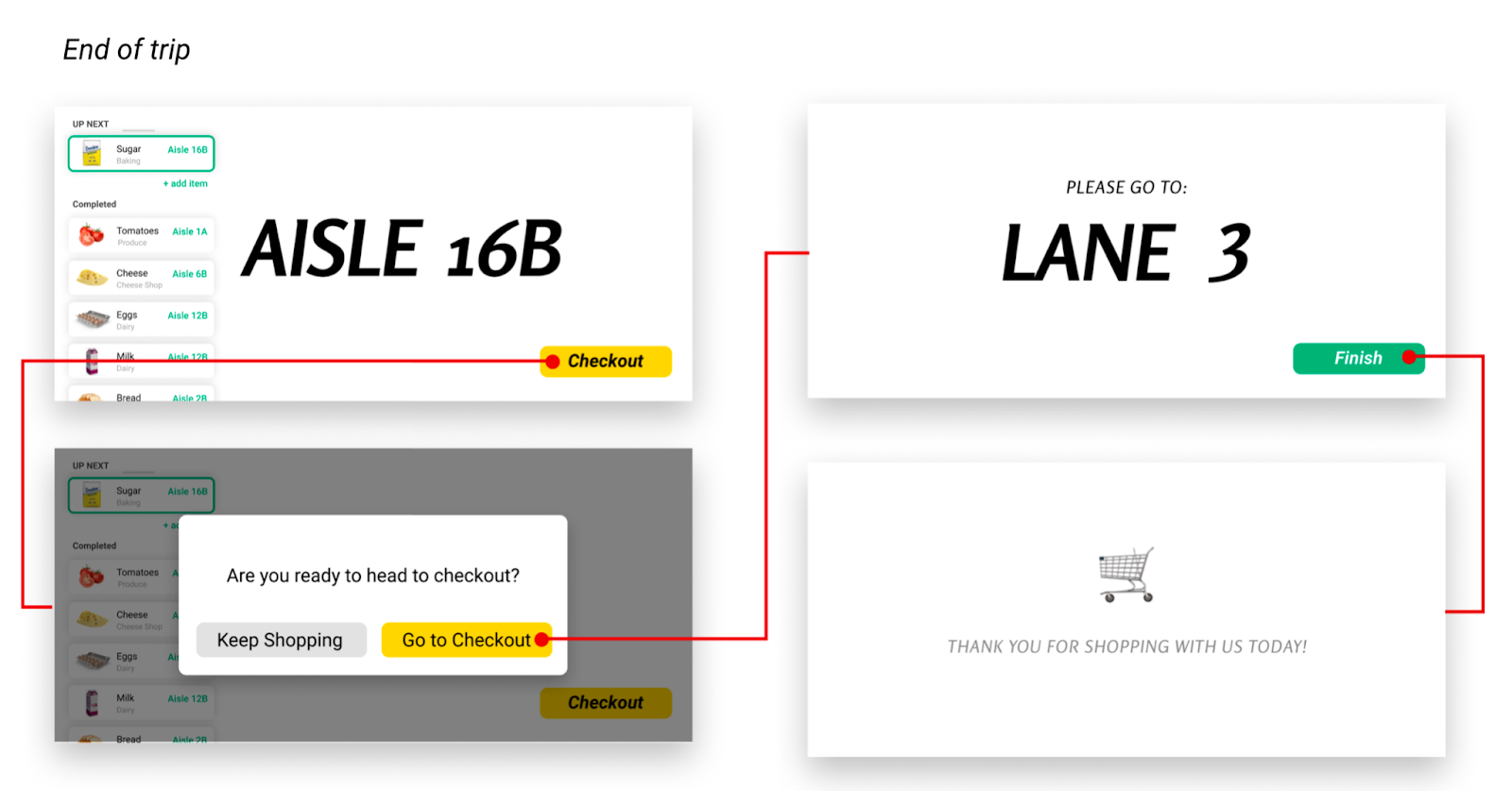
Part 2: Environmental intervention
While we didn't have a physical prototype of the indicator lights aside from colored sticky notes to test with participants, below is the proof of concept I mocked up in Blender. The indicator lights are attached to each aisle sign, turning green (zero to light traffic) and red (medium to heavy traffic) to respond to the real-time conditions of each aisle. Participants noted they don’t need more details beyond this. At the base, the lights include a sensor to inform the system of how many carts are in an aisle, with the store setting its own minimum or threshold for activating the red light.
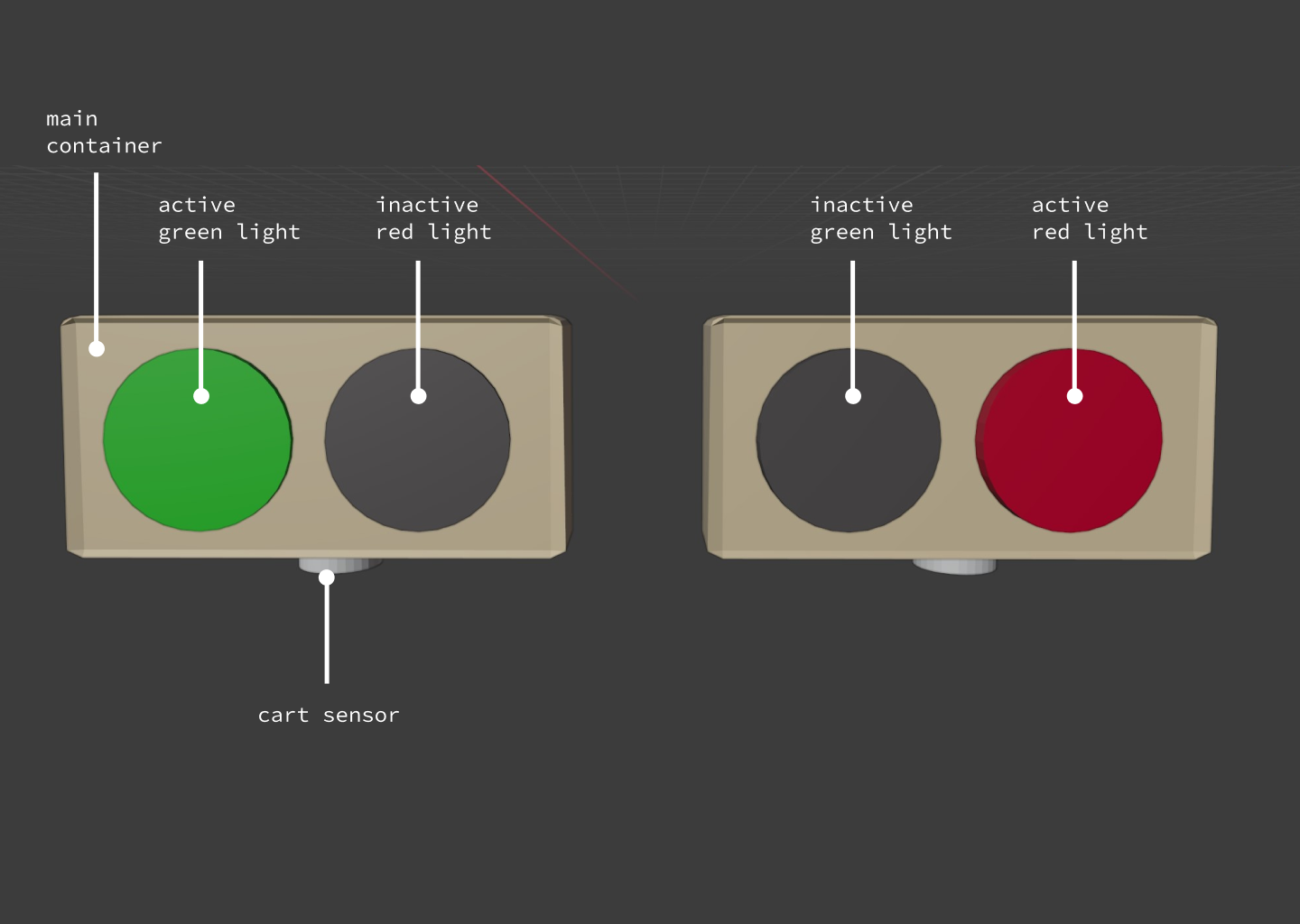
In-store indicator lights - front view
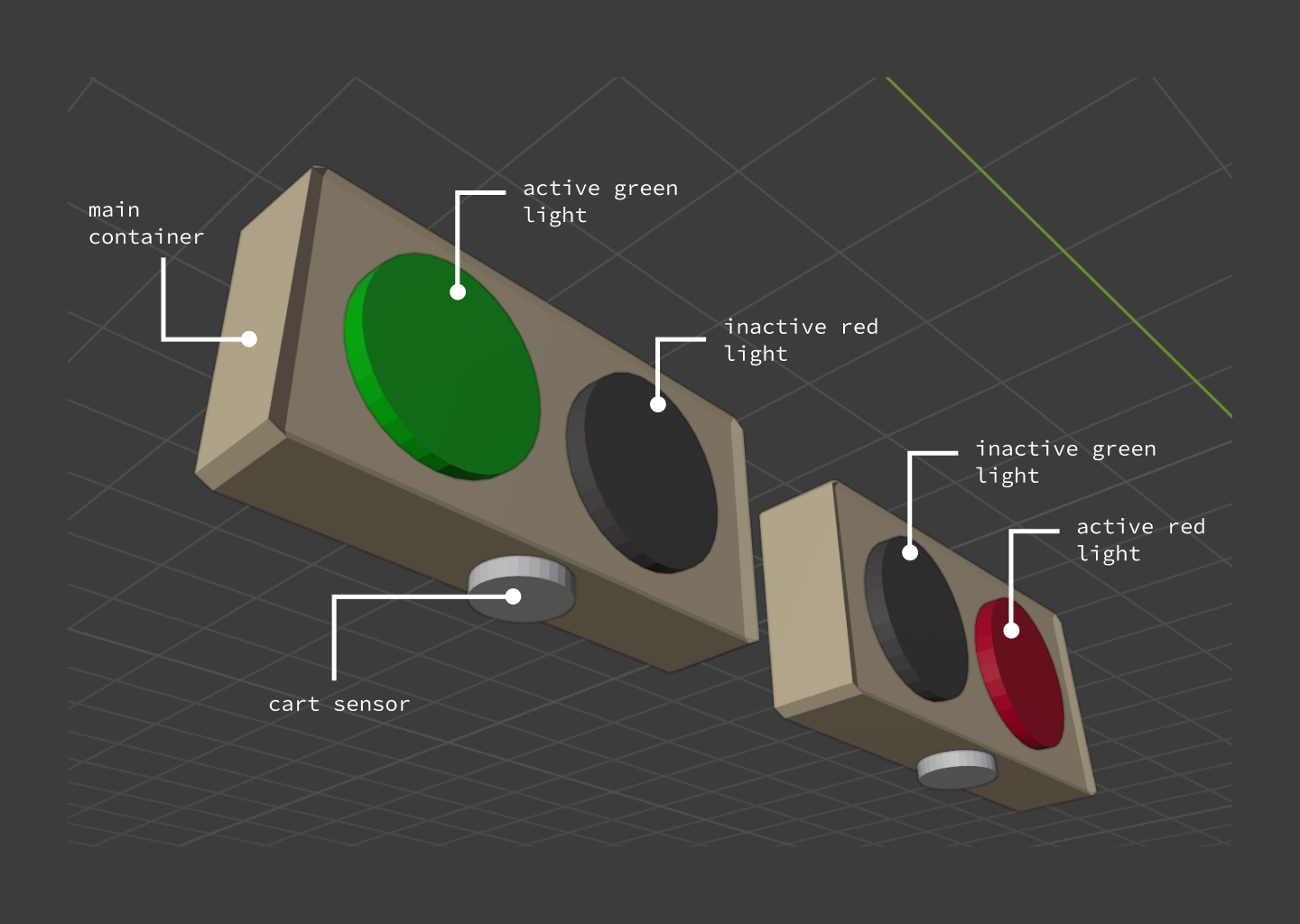
In-store indicator lights - angled view
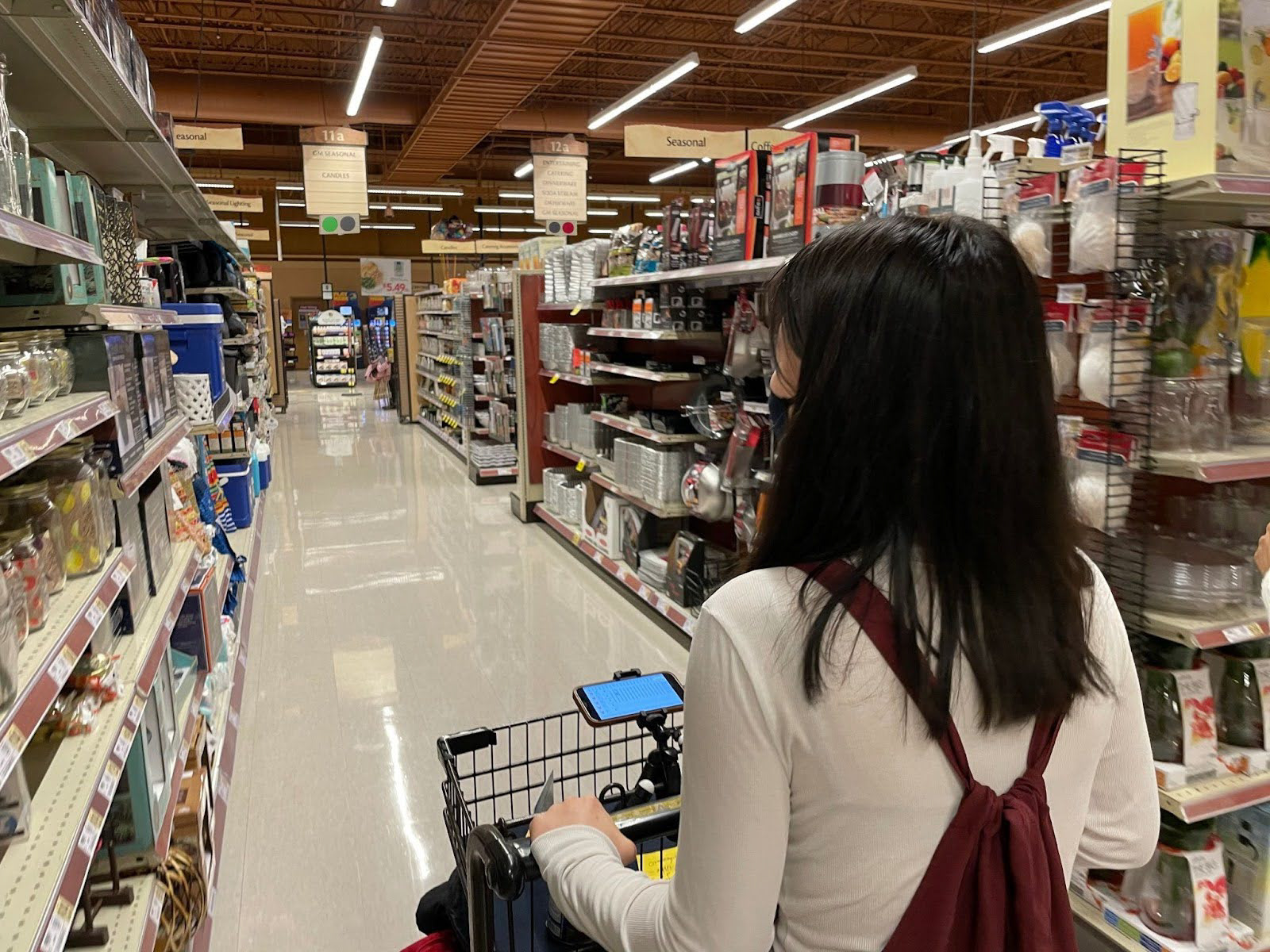
Proposed light system
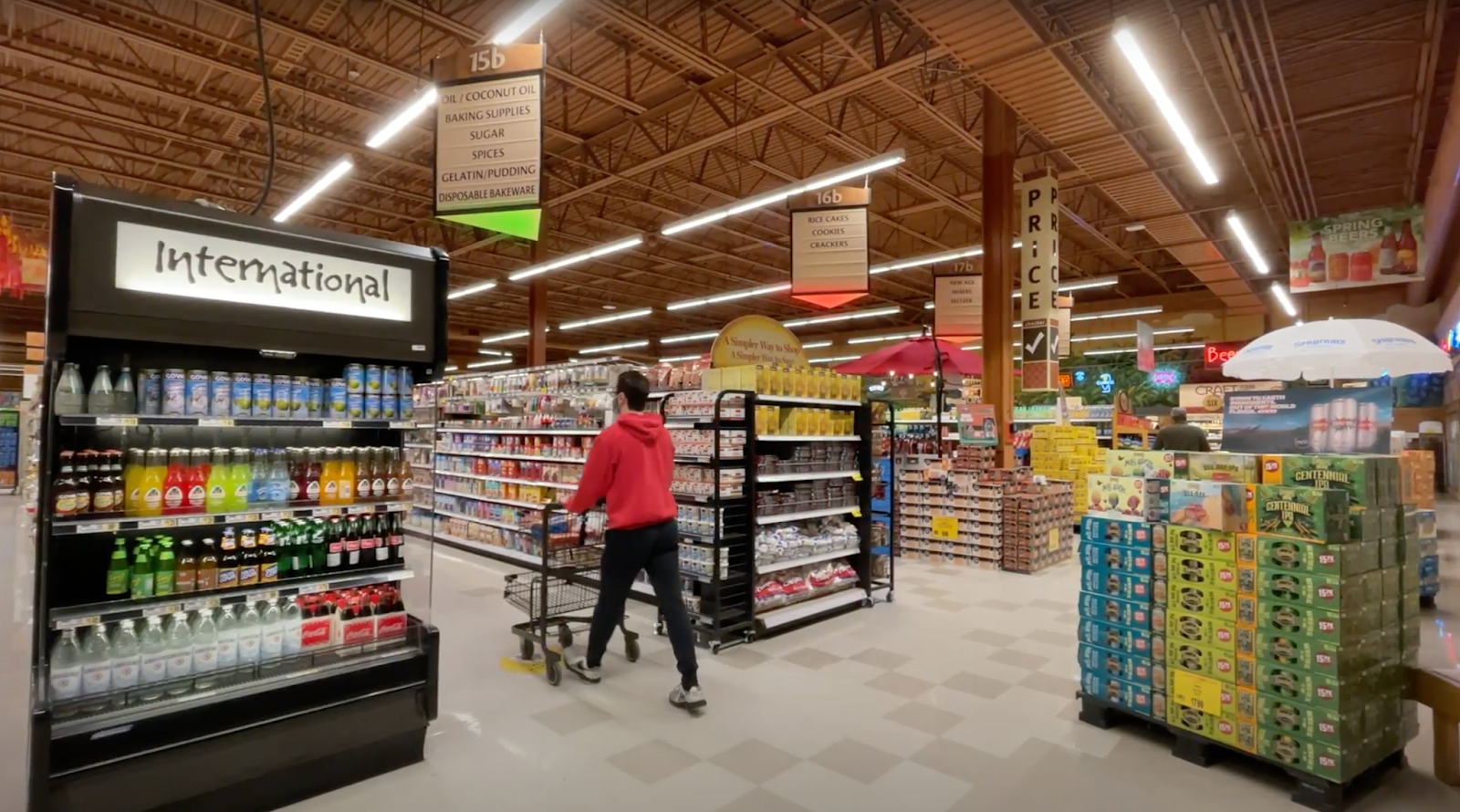
Alternative light system
Discussion and conclusion
This paper explores the behavioral foundations of consumers' social interactions, focusing on how situational and environmental elements affect the grocery shopping experience of college students. Through ethnographic and user enactment studies, we identified key factors influencing shoppers' responses to their surroundings, revealing that they prioritize control and agency while fearing inconvenience to others. Our design concept aimed to balance these priorities by empowering individuals and crowds to self-regulate using a digital navigation tool and indicator light system. While the intervention successfully addressed social stressors, we recognize that time and resource constraints made it difficult for us to fully explain the variability in participants' coping methods. A more in-depth psychological exploration could have enhanced our understanding of these behaviors. Ultimately, our ethnographic approach expanded upon existing research and led to a design solution that not only addresses crowd-induced stress, but offers lasting improvements to the grocery shopping experience.
Read our full paper for more details about our study.